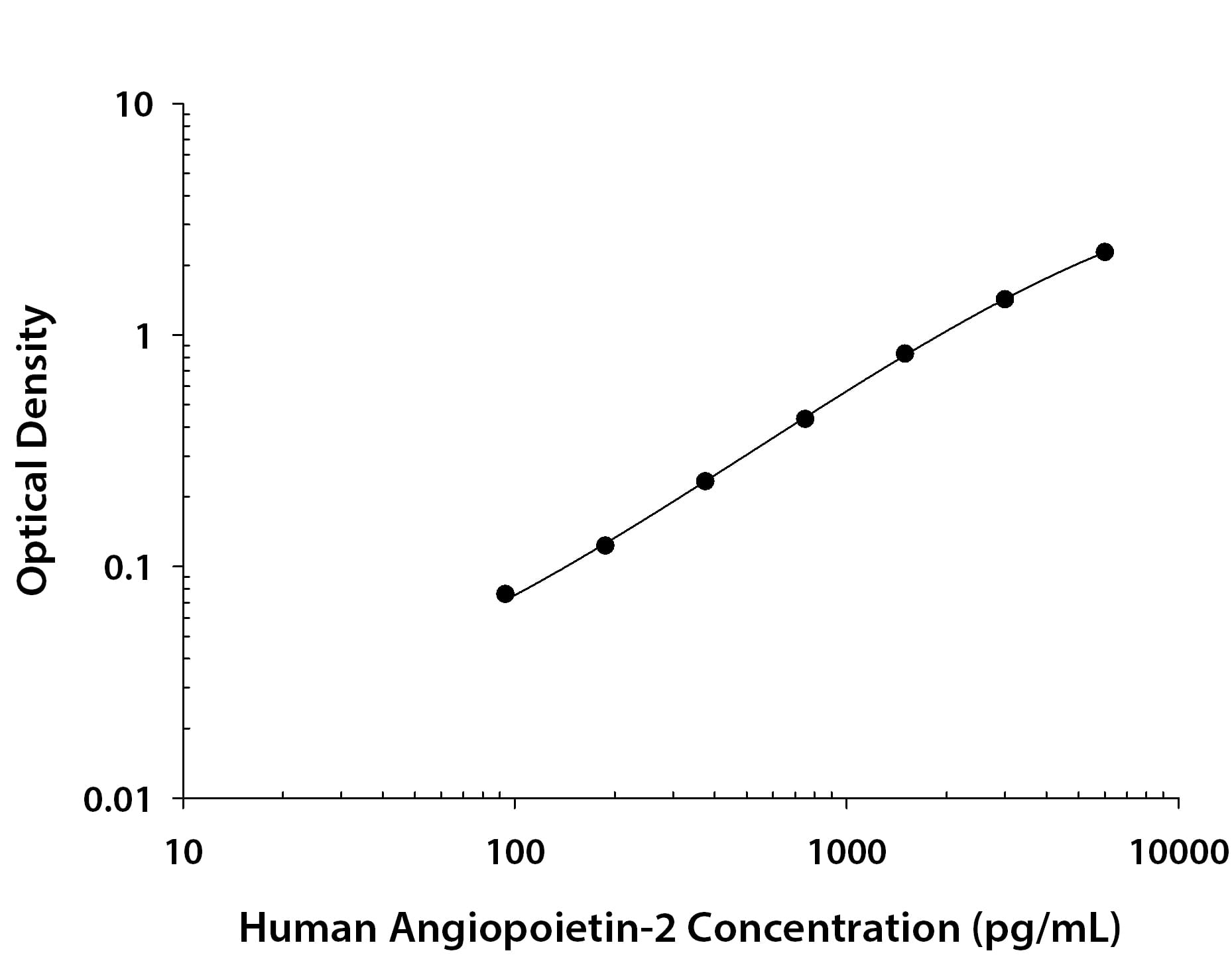Human Angiopoietin-2 Antibody
R&D Systems, part of Bio-Techne | Catalog # MAB0984

Key Product Details
Species Reactivity
Applications
Label
Antibody Source
Product Specifications
Immunogen
Asp68-Phe496
Accession # O15123
Specificity
Clonality
Host
Isotype
Scientific Data Images for Human Angiopoietin-2 Antibody
Human Angiopoietin‑2 ELISA Standard Curve.
Recombinant Human Angiopoietin-2 protein was serially diluted 2-fold and captured by Mouse Anti-Human Angiopoietin-2 Monoclonal Antibody (Catalog # MAB098) coated on a Clear Polystyrene Microplate (Catalog # DY990). Mouse Anti-Human Angiopoietin-2 Monoclonal Antibody (Catalog # MAB0984) was biotinylated and incubated with the protein captured on the plate. Detection of the standard curve was achieved by incubating Streptavidin-HRP (Catalog # DY998) followed by Substrate Solution (Catalog # DY999) and stopping the enzymatic reaction with Stop Solution (Catalog # DY994).Applications for Human Angiopoietin-2 Antibody
ELISA
This antibody functions as an ELISA detection antibody when paired with Mouse Anti-Human Angiopoietin‑2 Monoclonal Antibody (Catalog # MAB098).
This product is intended for assay development on various assay platforms requiring antibody pairs. We recommend the Human Angiopoietin-2 DuoSet ELISA Kit (Catalog # DY623) for convenient development of a sandwich ELISA or the Human Angiopoietin-2 Quantikine ELISA Kit (Catalog # DANG20) for a complete optimized ELISA.
Reviewed Applications
Read 1 review rated 5 using MAB0984 in the following applications:
Formulation, Preparation, and Storage
Purification
Reconstitution
Formulation
Shipping
Stability & Storage
- 12 months from date of receipt, -20 to -70 °C as supplied.
- 1 month, 2 to 8 °C under sterile conditions after reconstitution.
- 6 months, -20 to -70 °C under sterile conditions after reconstitution.
Background: Angiopoietin-2
Angiopoietin-2 (Ang-2; also ANGPT2) is a secreted glycoprotein that plays a complex role in angiogenesis and inflammation (1, 2). Mature Ang-2 is 478 amino acids (aa) in length. It contains one coiled-coil domain (aa 166-248) that mediates multimerization, and a C-terminal fibrinogen-like domain (aa 275-495) that mediates receptor binding. Under reducing conditions, secreted monomeric Ang-2 is 65-66 kDa in size. Under nonreducing conditions, both natural and recombinant Ang-2 form 140 kDa dimers, 200 kDa trimers, and 250-300 kDa tetramers and pentamers (3-6). Alternate splicing generates a short isoform that lacks 52 amino acids (aa) preceding the coiled-coil domain (4). Mature human Ang-2 shares 86% aa sequence identity with mouse and rat Ang-2. Ang-2 is widely expressed during development, but it is restricted postnatally to highly angiogenic tissues such as the placenta, ovaries, and uterus (3). It is particularly abundant in vascular endothelial cells (EC) where it is stored in intracellular Weibel-Palade bodies (1, 3, 7). Both Ang-2 and the related Angiopoietin-1 (Ang-1) are ligands for the receptor tyrosine kinase Tie-2 (2). While Ang-1 is a potent Tie-2 agonist, Ang-2 may act as either a Tie-2 antagonist or agonist, depending upon its state of multimerization. The higher the order of oligomer, the more effective Ang-2 becomes as a Tie-2 agonist (3, 8-11). The short isoform appears to block the binding of either Ang-1 or full-length Ang-2 to Tie-2 (4). Ang-2 functions as a pro-angiogenic factor, although it can also induce EC death and vessel regression (12, 13). Upon its release from quiescent EC, it regulates vascular remodeling by promoting EC survival, proliferation, and migration and destabilizing the interaction between EC and perivascular cells (8, 13, 14). Ang-2 is required for postnatal vascular remodeling, and it cooperates with Ang-1 during lymphatic vessel development (7, 15). It mediates the up-regulation of ICAM-1 and VCAM-1 on EC, which facilitates the adhesion of leukocytes during inflammation (16). Ang-2 is up-regulated in both the endothelium and tumor cells of several cancers as well as in ischemic tissue (17-20). Its direct interaction with Integrins promotes tumor cell invasion (21, 22). Ang-2 also promotes the neuronal differentiation and migration of subventricular zone progenitor cells (20).
References
- Augustin, H.G. et al. (2009) Nat. Rev. Mol. Cell Biol. 10:165.
- Murdoch, C. et al. (2007) J. Immunol. 178:7405.
- Maisonpierre, P.C. et al. (1997) Science 27:55.
- Kim, I. et al. (2000) J. Biol. Chem. 275:18550.
- Procopio, W.N. et al. (1999) J. Biol. Chem. 274:30196.
- Kim, K-T. et al. (2005) J. Biol. Chem. 280:20126.
- Gale, N.W. et al. (2002) Dev. Cell 3:411.
- Yuan, H.T. et al. (2009) Mol. Cell. Biol. 29:2011.
- Falcon, B.L. et al. (2009) Am. J. Pathol. 175:2159.
- Kim, H-Z. et al. (2009) Biochim. Biophys. Acta 1793:772.
- Kim, I. et al. (2001) Cardiovasc. Res. 49:872.
- Lobov, I.B. et al. (2002) Proc. Natl. Acad. Sci. 99:11205.
- Cao, Y. et al. (2007) Cancer Res. 67:3835.
- Nasarre, P. et al. (2009) Cancer Res. 69:1324.
- Dellinger, M. et al. (2008) Dev. Biol. 319:309.
- Fiedler, U. et al. (2006) Nat. Med. 12:235.
- Koga, K. et al. (2001) Cancer Res. 61:6248.
- Etoh, T. et al. (2001) Cancer Res. 61:2145.
- Tressel, S.L. et al. (2008) Arterioscler. Thromb. Vasc. Biol. 28:1989.
- Liu, X.S. et al. (2009) J. Biol. Chem. 284:22680.
- Hu, B. et al. (2006) Cancer Res. 66:775.
- Imanishi, Y. et al. (2007) Cancer Res. 67:4254.
Alternate Names
Entrez Gene IDs
Gene Symbol
UniProt
Additional Angiopoietin-2 Products
Product Documents for Human Angiopoietin-2 Antibody
Product Specific Notices for Human Angiopoietin-2 Antibody
For research use only
